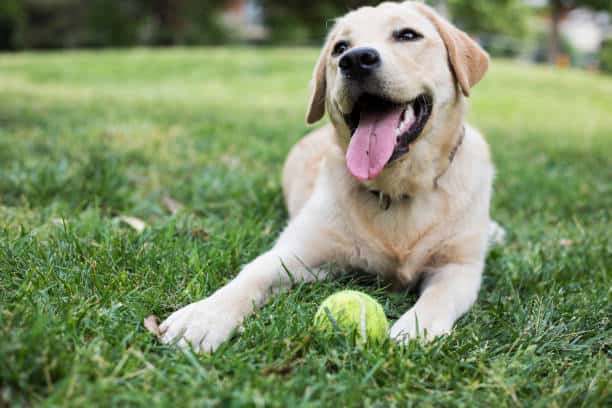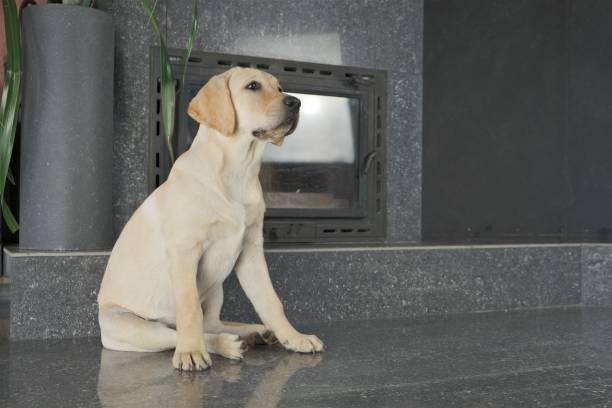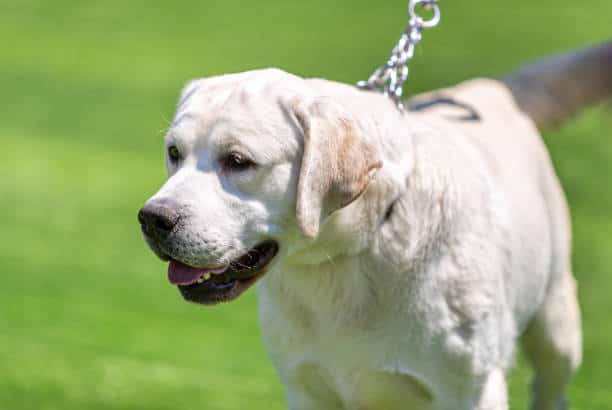Raising a 3-month-old Lab puppy can very often feel like an exciting yet complex challenge. Did you know that Labrador Retrievers are considered America’s 2nd most popular dog breed, courtesy of their friendly nature and adaptability?
This comprehensive guide provides insights into the physical and behavioral changes to expect, early training techniques to employ, proper nutrition practices, and more for your pup’s healthy life.
Growth of a Labrador Retriever: Life Stages
Labrador Retriever growth can be tracked using a Labrador Retriever Growth & Weight Chart, which provides average weight ranges for different ages.
Labrador Retriever Growth Charts
The growth and weight of a Labrador Retriever can be estimated using the following chart. This provides an average range for each age milestone, allowing you to track your Lab puppy’s development.
| Age | Male Weight Gain Range | Female Weight Gain Range |
|---|---|---|
| 1 Month | 5-10 lbs | 5-10 lbs |
| 2 Months | 10-20 lbs | 10-20 lbs |
| 3 Months | 20-30 lbs | 20-30 lbs |
| 4 Months | 30-45 lbs | 30-40 lbs |
| 6 Months | 40-55 lbs | 30-35 lbs |
| 1 Year | 65-80 lbs | 55-70 lbs |
| 1.5 Years | 65-80 lbs (Larger-boned puppies may still be growing) | 55-70 lbs (Larger-boned puppies may still be growing) |
Paw size, genetics, and overall health can influence their growth, and some larger-boned Labs may continue to grow until they are 18 months old.
When do Labs stop growing?
Labs reach their mature size around one year of age, with some larger-boned puppies continuing to develop until they’re 18 months old. A common trait among Labradors is their distinct sturdy and muscular build that’s longer than it is tall.
This growth pattern makes these pups stand out regarding physical characteristics, including their trademark “otter tail.” According to the Labrador Retriever weight chart, your puppy’s growth can be accurately predicted until it reaches its fully grown stage between 12 and 18 months.
Staying vigilant about your lab’s growth pace can help prevent obesity problems, as Labs are prone to gaining excess weight if overfed or under-exercised.
What to Expect from Your 3-Month-Old Lab Puppy?
At 3 months old, your Labrador Retriever puppy is going through a range of physical and behavioral changes.
Physical changes
Your 3-month-old Lab puppy is going through a rapid growth phase. They are sporting their adolescent coat and will have shed the soft baby fur they were born with. You may notice their legs extending as they experience yet another growth spurt.
A male Lab at this stage typically weighs between 20 to 30 pounds, while a female Labrador might weigh slightly less. One signature trait that becomes evident is the distinct “otter” tail – thick at the base and tapering off towards the end, typical of this breed.
Despite these changes, remember your Labrador Retriever won’t reach its full size until around their first birthday or even up to 18 months for larger-boned puppies, according to American Kennel Club Official Standards.

Behavioral changes
As your Labrador Retriever puppy reaches the three-month mark, you can expect to see some significant behavioral changes. At this stage of development, your pup is becoming more curious and adventurous.
They may start exploring their surroundings more confidently, testing boundaries and pushing limits. Their socialization skills will begin to blossom as they become increasingly interested in interacting with other dogs and people.
Positive reinforcement for good behavior is key during this crucial period of their growth. Remember that consistency is key when training your lab puppy. Helping them understand what is expected of them as they continue to learn and grow into well-mannered adult dog.
Training Your 3-Month-Old Lab Puppy
At 3 months old, it’s crucial to begin training your Lab puppy with basic obedience commands such as sit and come.
Importance of early and advanced training
Early training is of utmost importance for your 3-month-old Labrador puppy. This stage in their development sets the foundation for obedience and manners as they grow into adult dogs.
Training at this age helps them understand basic commands like sit and come, essential for their safety and well-being. Starting early, you can instill good behavior patterns before any unwanted habits develop.
Positive reinforcement training methods should be employed to ensure effective learning without any negative consequences. With consistent and patient training, your Lab will become a well-behaved companion for life.
Basic training: Sit and Come commands
Basic obedience training is essential for a 3-month-old lab puppy. It helps establish important communication and sets the foundation for good behavior. Here are some key aspects of training your lab puppy:
Start with the “Sit” command:
Hold a treat close to the puppy’s nose, then slowly move it upwards. As their head follows the treat, their bottom will naturally lower into a sitting position.
Once they are seated, reward them with the treat and praise. Repeat this process multiple times throughout the day to reinforce the command.
Teach the “Come” command:
This command is crucial for keeping your lab puppy safe and under control.
- Start in a small enclosed area like your house or backyard.
- Get down to their level and use an excited tone of voice while calling their name followed by “Come!”
- Use treats or toys as rewards when they come to you. As they become more responsive, gradually introduce distractions in controlled environments.
Be consistent:
Consistency is key in training your lab puppy. Use clear verbal cues along with hand signals to reinforce commands consistently across all family members or trainers involved. This consistency helps them understand what is expected of them.
Use positive reinforcement:
Labs respond well to positive reinforcement techniques like treats, praise, and petting. Rewarding desired behaviors strengthens their understanding of what you want them to do and encourages repetition.
Keep training sessions short:
Puppies have short attention spans, so it’s important to keep training sessions brief but frequent. Aim for several short sessions throughout the day rather than one long session. This way, your lab puppy will stay engaged and enthusiastic about learning.

Puppy training schedule in crate
Crate training is an essential part of raising a 12-week-old Labrador puppy. It provides them with a safe and comfortable space that they can call their own. Here are some key points to keep in mind when introducing your puppy to crate training:
STEP 1
Start by making the crate a positive and inviting space for your puppy. Place soft bedding, toys, and treats inside to encourage them to explore and enter willingly.
STEP 2
Keep the crate in a central area of your home where your family spends most of their time. This will help your puppy feel more secure and included in daily activities.
STEP 3
Use positive reinforcement to associate the crate with positive experiences. Reward your puppy with treats and praise whenever they willingly enter or remain calm inside the crate.
STEP 4
Gradually increase the duration of time your puppy spends in the crate. Start with short periods, such as 10 minutes, and gradually extend it over time. Remember not to leave them in the crate for too long as puppies have limited bladder control.
STEP 5
Never use the crate as a form of punishment. Your puppy should view it as a safe haven rather than a place associated with negative experiences.
STEP 6
Avoid forcing your puppy into the crate or using physical restraint. This can create fear or anxiety towards the crate, making future training more challenging.
STEP 7
Introduce a consistent routine for crating, such as using specific cues like “crate” or “bedtime” when you want them to enter. This helps establish clear communication between you and your puppy.
STEP 8
Monitor your puppy’s behavior while they are in the crate. If they become anxious or excessively whine or bark, try soothing them with calming words or by placing an item with your scent inside.

House training your puppy
Housebreaking your puppy is an important aspect of their training and will help establish good habits from an early age.
Here are some key tips to help you with housebreaking your 3-month-old Lab puppy:
- Create a consistent schedule for bathroom breaks. Take your puppy outside every few hours, especially after meals or naps. Puppies have small bladders and need frequent opportunities to relieve themselves.
- Choose a designated potty area in your yard. This will help your puppy associate that spot with going to the bathroom. Always take them to the same spot each time.
- Use positive reinforcement when your puppy goes in the right place. Praise them enthusiastically and give them treats as rewards. This will reinforce the behavior you want to see.
- Supervise your puppy indoors to prevent accidents. Keep them confined to a small area or use a crate when you can’t watch them closely. Gradually give them more freedom as they become more reliable with their bathroom habits.
- Watch for signs that your puppy needs to go outside, such as sniffing, circling, or whining. If you see these signs, immediately take them outside to their designated potty area.
- Clean up accidents thoroughly using an enzyme – based cleaner. This will eliminate any lingering odor that could return your puppy to the same spot.
- Be patient and consistent with housebreaking. It takes time for puppies to develop bladder control and understand where to go to the bathroom.
Role of Socialization in Labrador Retrievers Development
Socialization is vital to your puppy’s development, particularly when they are around 3 months old. They start forming important connections with the world around them during this period.
Socializing your Labrador Retriever at an early age helps them become well-adjusted adult dogs. Leash training can be introduced at this age. Exposing your puppy to different people, animals, and environments, you are helping them learn how to interact positively with their surroundings.
This includes introducing them to new sights, sounds, smells, and experiences. Proper socialization also helps prevent fear-based behaviors as your pup grows older.
Labradors are known for their friendly nature and adaptability, making socialization even more crucial for this breed. Since Labradors were originally bred as water dogs, it’s important to introduce them to water at an early age as part of their socialization process.

Introducing your Lab puppy to different environments
To ensure the well-rounded development of your Lab puppy, it’s important to introduce them to different environments. This will help build their confidence and adaptability as they grow. Here are some key environments you should expose your Lab puppy to:
Your home:
Start by familiarizing your Lab puppy with their new surroundings. Allow them to explore different areas of the house and get accustomed to various rooms.
Outdoor spaces:
Take your Lab puppy for short walks in different outdoor settings such as parks, sidewalks, and residential areas. This will help them become comfortable with new sights, sounds, and smells.
Socialization with other dogs:
Arrange playdates with well-behaved and fully vaccinated dogs in a safe environment. This interaction is crucial for developing proper canine communication skills and ensuring your Lab gets along well with other dogs.
Meeting new people:
Introduce your Lab puppy to different individuals, including children, adults, and seniors. Encourage gentle interactions and positive experiences with people of varying ages to promote good social behavior.
Different surfaces:
Expose your Lab puppy to different types of surfaces like grass, concrete, carpeting, hardwood floors, or sand. This will help them become comfortable walking on various textures.
Car rides:
Gradually introduce car rides to your Lab puppy so they can become accustomed to traveling in vehicles. Start with short trips around the neighborhood before venturing on longer journeys.
Public places:
Take your Lab puppy for outings to pet-friendly establishments like cafes or stores that allow dogs. This will expose them to new sights, sounds, and people while practicing proper behavior in public spaces.
Ensuring the Health of Your 3-Month-Old Lab Puppy
Ensure your 3-month-old Lab puppy’s health and well-being with regular veterinary check-ups and a proper diet.
Regular veterinary check-ups
Regular veterinary check-ups are essential for the health and well-being of your 3-month-old Lab puppy. These check-ups allow the veterinarian to monitor your puppy’s growth, identify any potential health issues early on, and provide preventive care measures.
Labs are prone to certain health problems like hip dysplasia, allergies, and skin issues, so regular visits to the vet can help prevent or manage these conditions.
Veterinarians can offer advice on nutrition, vaccinations, and other aspects of puppy care.By scheduling regular check-ups, you can ensure a happy and healthy start for your Labrador Retriever.
Proper High-quality food and nutritional requirements
Proper nutrition is essential for a lab puppy’s healthy growth and development. As they grow rapidly, provide them with measured cups of food that meet their nutritional needs.
A high-quality puppy wet food specifically formulated for large-breed puppies is recommended, as it contains the right balance of nutrients to support their bone and muscle development.
- Avoid overfeeding your lab puppy, as excess weight can strain their joints and lead to health issues later in life.
- Regular feeding schedules with measured portions of home-cooked food will help maintain a healthy weight.
- Consult with your veterinarian to determine which high-quality food is great based on your puppy’s age, size, and activity level.
- A mix of dry food, raw food and solid food is best. Additionally, ensuring access to fresh water at all times in a food bowl is vital for proper hydration.
Labrador Retrievers have specific dietary needs due to their predisposition toward certain health issues like hip dysplasia and obesity. By providing them with high-quality dog food from an early age, you can set them up for adult dog food soon.
FAQ
What should I expect from my 3-month-old lab puppy?
At 3 months old, your Labrador Retriever puppy is going through significant growth and development. Physically, you can expect them to gain weight since you first brought them home, but they still have more growing.
Their energy level is also increasing, so be prepared for an energetic and playful companion. This is a critical time for training and socialization as your puppy starts to form lifelong habits and behaviors.
They may also develop baby teeth during this stage, so provide chew toys. The milk teeth or puppy teeth makes them want to bit or niggle onto things. A bully stick is best. Remember that Labs are known for their friendly nature, adaptability, and love of playtime with both humans and other dogs.
How big is a 3 month Labrador puppy?
At 3 months old, a Labrador puppy is still in the early stages of growth but has already started to gain some size and weight.
On average, a 3-month-old male Lab weighs between 18 to 26 pounds (8 to 11.8 kilograms), while females weigh around 15 to 22 pounds (6.8 to 9.9 kilograms).
Although their size may vary slightly depending on genetics and individual development, these weight ranges provide a general idea of how big your furry friend will be at this stage.
How much should a 3-month-old lab puppy eat?
At 3 months old, a Labrador Retriever puppy should eat about 1.5 to 2 cups of food per day, divided into three meals. It’s important not to overfeed your puppy as Labs are prone to obesity, which can lead to health problems down the line.
Obesity in dogs can exacerbate joint issues like hip dysplasia and arthritis, so it’s crucial to feed your Lab the appropriate amount based on their age and weight.
At what age are labs potty trained?
Labrador Retrievers can be subject to potty training between four and six months of age. However, remember that every puppy is different and may require more or less time to grasp the concept.
Consistency is key when it comes to potty training your Lab puppy. Establish a routine, take them outside frequently, and reward them for going in the designated area.
Accidents are bound to happen during training, so patience and positive reinforcement are crucial. Regular bathroom breaks and positive reinforcement will help your Lab learn where to do their business as they grow into well-behaved adult dog.
Author Profile

- Lifetime dog Enthusiast
- Shradha is a seasoned writer at Labradorandyou.com, an authoritative resource for all things Labrador Retriever. Her experience as a pet owner and dog enthusiast drives her to create meticulously researched and fact-checked content, offering valuable insights on Labrador training, grooming, and health. Each article reflects Shradha's passion and dedication, enriched by personal experiences with her beloved Labradors, Tom, and Kurt. Whether exploring breed-specific training techniques or providing product reviews, Shradha ensures Labrador owners receive the most accurate, up-to-date, and trustworthy information, aimed at enhancing their companions' health and happiness
Also by the author
-
 Lab-TypesJune 30, 2025Мостбет Букмекер: Официальный Сайт Игровых Автоматов Mostbet Bookmaker
Lab-TypesJune 30, 2025Мостбет Букмекер: Официальный Сайт Игровых Автоматов Mostbet Bookmaker
-
 MonobrandJune 30, 2025Fontan Casino ️ One Hundred Pln Darmowy Zakład Bez Depozytu
MonobrandJune 30, 2025Fontan Casino ️ One Hundred Pln Darmowy Zakład Bez Depozytu
-
 Lab-TypesJune 30, 20251xbet Зеркало рабочее На Сегодня прохода На Сайт 1хбет Обновлено!
Lab-TypesJune 30, 20251xbet Зеркало рабочее На Сегодня прохода На Сайт 1хбет Обновлено!
-
 Lab-TypesJune 30, 2025Мостбет Mostbet Букмекерская Контора: Зеркало, Официальный Сайт, Бонус При Регистрации
Lab-TypesJune 30, 2025Мостбет Mostbet Букмекерская Контора: Зеркало, Официальный Сайт, Бонус При Регистрации





